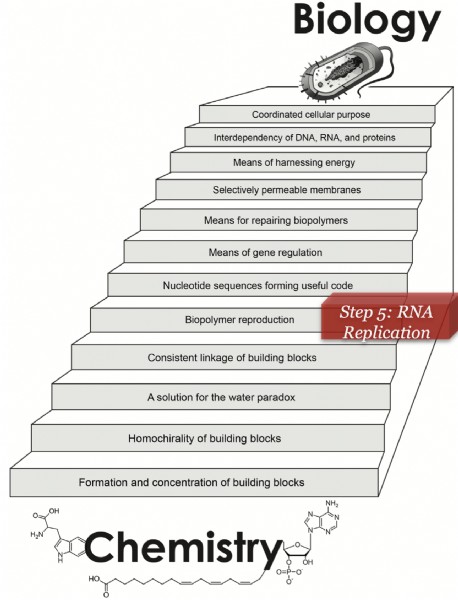 In the opening chapters of Genesis, we find that God creates through division; for instance, God divided the light from darkness. Nearly any definition of life includes the ability to reproduce. In fact, the theory of evolution requires this ability, so that mistakes called mutations can change the genetic code, perhaps giving the cell a new function. Reproduction is critical to life; so just how hard is it for a strand of RNA to copy itself on its own? It’s astronomically hard.
In the opening chapters of Genesis, we find that God creates through division; for instance, God divided the light from darkness. Nearly any definition of life includes the ability to reproduce. In fact, the theory of evolution requires this ability, so that mistakes called mutations can change the genetic code, perhaps giving the cell a new function. Reproduction is critical to life; so just how hard is it for a strand of RNA to copy itself on its own? It’s astronomically hard.
Turns out that even in living organisms, not even the tiniest molecule is “autocatalytic”, or self-replicating. We’ve all seen science films where one wiggly cell splits into two, but that view hides molecular motors such as enzymes which are critical to the task. It’s easy to build a perfect copy of your coffee table compared to the simplest molecular copying task: RNA replication. Simply put, RNA replicates when it aligns its parts to match the order and sequence of DNA’s parts to mimic them, then move outside DNA’s house (nucleus) to arrive at the protein machine shop (ribosomes). Used this way, RNA serves as an inverse copy (or film negative) of a piece of DNA.
Though less accurate, we could compare it to making a toy tower out of magnetic balls and sticks (see annotated photos below). This illustration is helpful since DNA’s parts (called nucleotides) are attracted to each other, like the north and south poles of a magnet. RNA replication (magnet template, left) requires an enzyme (kid’s hands, center) to keep the monomers (balls, sticks) apart. Ribosomes then fold and shape them into a protein (toy tower, right). Applying random energy (shaking the pieces) to the parts without this enzyme only makes a mess (see photo, right).

 Experiments over 50 years ago to self-replicate short strands of RNA ran into this same hurdle, yet they still declare success —even to this day— because the researchers assume the enzyme (called Qß replicase) just happens to be on hand. They don’t give a reason how this critical enzyme, which keeps the strand from getting tangled with itself while separating the copy from the RNA template, ever arrives on primitive earth. University of Missouri professor Dr. Change Laura Tan calculates the odds of RNA correctly evolving into a short 135-nucleotide-long chain as one chance in 1.9 x 1081. This is roughly equal to the number of atoms in the entire universe – so to make an extra copy of this one randomly produced strand requires more material than is in the cosmos. Dr. Tan writes, “it would seem that even a vivid imagination has a difficult time arriving at a viable pathway for a self-replicating RNA – that is, unless the vivid imagination includes the ability to dismiss inconvenient truths.”
Experiments over 50 years ago to self-replicate short strands of RNA ran into this same hurdle, yet they still declare success —even to this day— because the researchers assume the enzyme (called Qß replicase) just happens to be on hand. They don’t give a reason how this critical enzyme, which keeps the strand from getting tangled with itself while separating the copy from the RNA template, ever arrives on primitive earth. University of Missouri professor Dr. Change Laura Tan calculates the odds of RNA correctly evolving into a short 135-nucleotide-long chain as one chance in 1.9 x 1081. This is roughly equal to the number of atoms in the entire universe – so to make an extra copy of this one randomly produced strand requires more material than is in the cosmos. Dr. Tan writes, “it would seem that even a vivid imagination has a difficult time arriving at a viable pathway for a self-replicating RNA – that is, unless the vivid imagination includes the ability to dismiss inconvenient truths.”
The Bible says the Lord God formed man of the dust of the ground. He did not direct random events. As the all-wise Creator, only He could have shaped such complex machines against all odds.
Source: Dr. Change Laura Tan and Rob Stadler, The Stairway To Life: An Origin-of-Life Reality Check, Evorevo Books, 2020, simplified summary of chapter 11.
Like this? Consider sharing it to Facebook by clicking the linked icon below.
